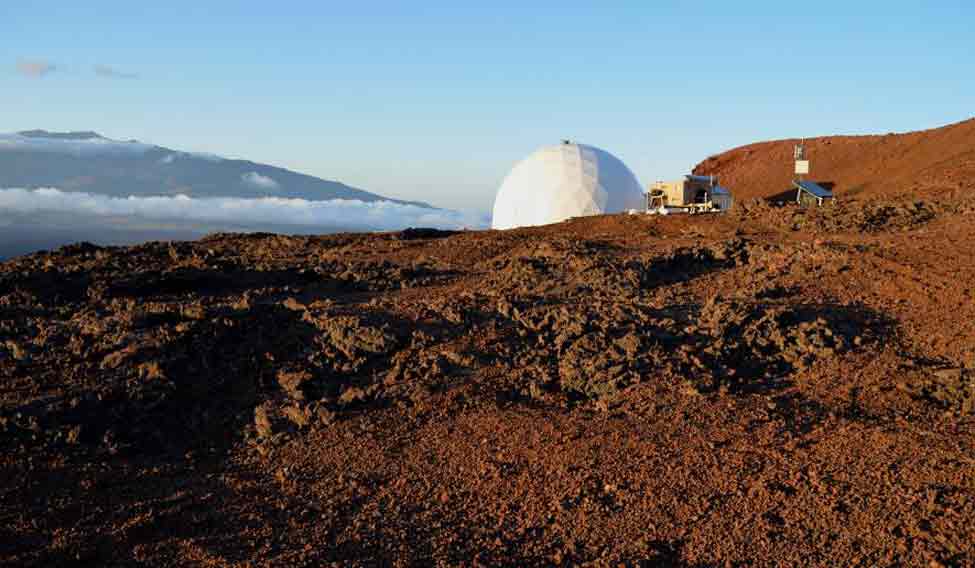Imagine living in isolation, under a solar-powered dome on the barren slopes of a volcano for 365 days. No phone calls from family, no visits from friends. That's not all—you have to walk around in a space suit. Sounds insane? But this is exactly what six volunteers underwent as part of an experiment to simulate living conditions on Mars. Funded by NASA, the project named The Hawaii Space Exploration Analog and Simulation, or HI-SEAS, ended on Sunday when the crew exited their habitat near the Mauna Lao volcano in Hawaii.
The project was designed to see how to cope with long-term isolation and stressful conditions that astronauts would have to endure during a real manned mission to the Red Planet.
It was an interesting mix of people—an astrobiologist, a physicist, a hydrologist, a space architect, a neuroscientist and an engineer. Lack of fresh food and water may not have cracked them up, but boredom did. Boredom was the biggest challenge they faced, the team said. “We were always in the same place, always with the same people," said French astrobiologist Cyprien Verseux, in an interview posted by organisers on Twitter. It was a test of how the bunch could cope with each other, bumping into each other every other time in extremely confined quarters. The dome, which the team referred to as 'habitat', is a 1,200 square feet space with small sleeping areas for the crew and a kitchen, laboratory, bathroom and composting toilets.
The crew had limited access to internet and email. But there was a 20-minute delay to send or receive an email, to simulate the time it takes to transmit a message between Mars and Earth.
All the crew members maintained blogs throughout the experiment to share personal experiences, feelings and a lot of intriguing details. In one of the blog posts, team member Verseux writes, “No juicy barbecue ribs, unfortunately. As there is no Walmart between Earth and Mars, all the food we packed is shelf-stable. Vegetables are freeze-dried, meat comes as cubes to rehydrate, fruits are dryer that in your muesli, and orange juice is powdered–as are milk and eggs.” And who cooks? All of them had to take turns.
 The dome was set up on the barren slopes which resembled the Martian surface | Pic courtesy: University of Hawai'i
The dome was set up on the barren slopes which resembled the Martian surface | Pic courtesy: University of Hawai'i
How would have their brains coped with the extreme isolation and lack of interesting inputs? Did things fall apart? Did they miss stepping on to Earth and a normal life? In a post, the team doctor Sheyna Gifford wrote: “For a few months after the mission first began I would have sort of waking dreams–bright moments where, for an instant, I would be standing somewhere on Earth. New Orleans. Boston Harbor. A street corner in New York City where I used to buy falafel and watch people walk their dogs...Then, I would blink and it would be gone. I called them “Earthflashes”.”
Monotony kills. When you are stuck in a dome with the same people for an year, it was important to have a celebration to break the monotony and boost the team's morale. And this is exactly what they did when they celebrated Christmas, in their own Martian way. At approximately 8,200 feet above sea level, there were no Christmas lights, no ginger bread, no wine. Only a plastic Christmas tree and hand-crafted presents. And a delectable dinner, of course. Cubes of dehydrated turkey were rehydrated and amalgamated to make turkey-shaped turkey meat. And luckily, their tomato plant, a dwarf variety developed for space flight had begun giving its first cherry tomatoes, just in time for Christmas.
The crew members were the objects of study themselves with body movement trackers and hormonal tests, and between all the frenzy, they would carry out research in their areas of expertise. The studies will allow researchers to recommend strategies for crew composition for such missions, and to determine how best to support such crews while they are working in space.
Hundreds of people from around the world apply to be part of HI-SEAS missions; this being the fourth one and the longest. From the pool of candidates, a panel of space experts picks 'astronaut-like' crew members. The candidate criteria include an undergraduate degree in science or engineering, at least three years of research experience or graduate study. Recruitments are already in place for next two missions scheduled to begin in 2017 and 2018.







